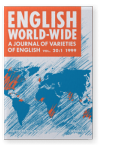Vol. 20:1 (1999) ► pp.35–65
The Trilateral Process in Cameroon English Phonology
Underlying Representations and Phonological Processes in Non-Native Englishes
With reference to Cameroon English (CamE), this paper proposes another way of analysing non-native English features: differing from the traditional approach which limits itself to surface forms, the paper proposes the tracing of deviations down to the underlying representation (UR) and suggests that RP URs (A) are restructured to autonomous CamE URs (B). While A undergoes RP phonological rules to surface as A', B may fail to undergo these processes; it may also undergo parallel — and quite often divergent — processes and surface as B'. For example, RP UR "s[^]cceed" (A) is restructured to CamE "s[u]cceed" (B). A becomes "s[^]cceed" by Vowel Reduction and B, which does not undergo this process, surfaces unchanged as "s[u]cceed" (B'). This process can be represented on a chart which has three sides: AA', AB and BB'. Hence the name Trilateral Process. It is observed that this model is more illuminating with respect to the dynamics of the differences between native and non-native Englishes than an analysis based solely on surface observation of deviations, for a catalogue of deviations lacks the explanatory insights of a trilateral analysis.
Cited by
Cited by 4 other publications
This list is based on CrossRef data as of 2 july 2024. Please note that it may not be complete. Sources presented here have been supplied by the respective publishers. Any errors therein should be reported to them.
